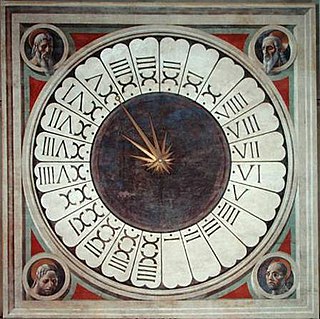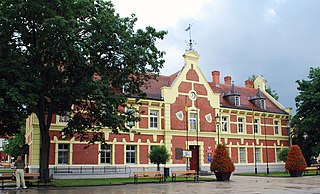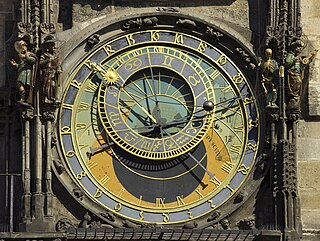
A pulsar clock is a clock which depends on counting radio pulses emitted by pulsars.

A pulsar clock is a clock which depends on counting radio pulses emitted by pulsars.
The first pulsar clock in the world was installed in St Catherine's Church, Gdańsk, Poland, in 2011. [1] It was the first clock to count the time using a signal source outside the Earth, other than sun dials. The pulsar clock consists of a radiotelescope with 16 antennas, which receive signals from six designated pulsars. Digital processing of the pulsar signals is done by an FPGA device. [2]
On October 5, 2011, a display showing the exact time of the pulsar clock, as a repeater of Gdańsk's pulsar clock, was installed in the European Parliament in Brussels, Belgium. [3]

A clock or a timepiece is a device used to measure and indicate time. The clock is one of the oldest human inventions, meeting the need to measure intervals of time shorter than the natural units such as the day, the lunar month and the year. Devices operating on several physical processes have been used over the millennia.

Pomeranian Voivodeship, Pomorskie Region, or Pomerania Province (Polish: Województwo pomorskie ;, is a voivodeship, or province, in northwestern Poland. The provincial capital is Gdańsk.
Time and frequency transfer is a scheme where multiple sites share a precise reference time or frequency. The technique is commonly used for creating and distributing standard time scales such as International Atomic Time (TAI). Time transfer solves problems such as astronomical observatories correlating observed flashes or other phenomena with each other, as well as cell phone towers coordinating handoffs as a phone moves from one cell to another.

Starogard Gdański is a city in Pomeranian Voivodeship in northern Poland with 48,328 inhabitants (2004).

A radio clock or radio-controlled clock (RCC), and often (incorrectly) referred to as an atomic clock is a type of quartz clock or watch that is automatically synchronized to a time code transmitted by a radio transmitter connected to a time standard such as an atomic clock. Such a clock may be synchronized to the time sent by a single transmitter, such as many national or regional time transmitters, or may use the multiple transmitters used by satellite navigation systems such as Global Positioning System. Such systems may be used to automatically set clocks or for any purpose where accurate time is needed. RC clocks may include any feature available for a clock, such as alarm function, display of ambient temperature and humidity, broadcast radio reception, etc.

The Tech Model Railroad Club (TMRC) is a student organization at the Massachusetts Institute of Technology (MIT). Historically it has been a wellspring of hacker culture and the oldest such hacking group in North America. Formed in 1946, its HO scale layout specializes in automated operation of model trains.

Nowy Dwor Gdanski is a town in Poland on the Tuja river in the Żuławy Wiślane region, capital of Nowy Dwór Gdański County, located in Pomeranian Voivodeship, with 10,171 inhabitants (2012).

An astronomical clock, horologium, or orloj is a clock with special mechanisms and dials to display astronomical information, such as the relative positions of the Sun, Moon, zodiacal constellations, and sometimes major planets.

A time ball or timeball is a time-signalling device. It consists of a large, painted wooden or metal ball that is dropped at a predetermined time, principally to enable navigators aboard ships offshore to verify the setting of their marine chronometers. Accurate timekeeping is essential to the determination of longitude at sea.

PSR B1919+21 is a pulsar with a period of 1.3373 seconds and a pulse width of 0.04 seconds. Discovered by Jocelyn Bell Burnell on 28 November 1967, it is the first discovered radio pulsar. The power and regularity of the signals were briefly thought to resemble an extraterrestrial beacon, leading the source to be nicknamed LGM, later LGM-1.

The Bajaj Pulsar is a range of motorcycles manufactured by Bajaj Auto in India. It was developed by the product engineering division of Bajaj Auto in association with Tokyo R&D, and later with motorcycle designer Glynn Kerr. A variant of the bike, the Pulsar 200NS was launched in 2012, but it was suspended for some time. With average monthly sales of around 86,000 units in 2011, Pulsar claimed a 2011 market share of 47% in its segment. By April 2012, more than five million units of Pulsar were sold. In 2018, they celebrated selling over ten million Pulsars backed an exclusive TV commercial and a marquee ride to in 6 cities to write "PULSAR" on a pre-defined route. The model is also sold as Rouser under other markets, such as South America.

Einstein@Home is a volunteer computing project that searches for signals from spinning neutron stars in data from gravitational-wave detectors, from large radio telescopes, and from a gamma-ray telescope. Neutron stars are detected by their pulsed radio and gamma-ray emission as radio and/or gamma-ray pulsars. They also might be observable as continuous gravitational wave sources if they are rapidly spinning and non-axisymmetrically deformed. The project was officially launched on 19 February 2005 as part of the American Physical Society's contribution to the World Year of Physics 2005 event.

A pulsar is a highly magnetized rotating neutron star that emits beams of electromagnetic radiation out of its magnetic poles. This radiation can be observed only when a beam of emission is pointing toward Earth, and is responsible for the pulsed appearance of emission. Neutron stars are very dense and have short, regular rotational periods. This produces a very precise interval between pulses that ranges from milliseconds to seconds for an individual pulsar. Pulsars are one of the candidates for the source of ultra-high-energy cosmic rays.

The 9 O'Clock Gun is a cannon located in Vancouver, British Columbia, Canada, that is ordinarily fired daily at 21:00 (9 p.m.) PT.

The Shepherd Gate Clock is mounted on the wall outside the gate of the Royal Observatory, Greenwich building in Greenwich, Greater London. The clock, an early example of an electrically connected clock system, was a sympathetic clock mechanism controlled by electric pulses transmitted by a motor clock inside the main building. The network of 'sympathetic clocks' was constructed and installed by Charles Shepherd in 1852. The clock by the gate was probably the first to display Greenwich Mean Time to the public, and is unusual in using the 24-hour analog dial. Also it originally showed astronomical time which started at 12 noon not midnight.

The Five-hundred-meter Aperture Spherical radio Telescope, nicknamed Tianyan, is a radio telescope located in the Dawodang depression (大窝凼洼地), a natural basin in Pingtang County, Guizhou, southwest China. FAST has a 500 m (1,600 ft) diameter dish constructed in a natural depression in the landscape. It is the world's largest filled-aperture radio telescope and the second-largest single-dish aperture, after the sparsely-filled RATAN-600 in Russia.

Quartz clocks and quartz watches are timepieces that use an electronic oscillator regulated by a quartz crystal to keep time. This crystal oscillator creates a signal with very precise frequency, so that quartz clocks and watches are at least an order of magnitude more accurate than mechanical clocks. Generally, some form of digital logic counts the cycles of this signal and provides a numerical time display, usually in units of hours, minutes, and seconds.
PSR J0437−4715 is a pulsar. Discovered in the Parkes 70 cm survey, it remains the closest and brightest millisecond pulsar (MSP) known. The pulsar rotates about its axis 173.7 times per second and therefore completes a rotation every 5.75 milliseconds. It emits a searchlight-like radio beam that sweeps past the Earth each time it rotates. Currently the most precisely located object outside of the Solar System, PSR J0437-4715 is 156.3 parsecs or 509.8 light-years distant.

St Catherine's Church is the oldest church in Gdańsk, Poland. It was a Protestant church from 1545 until the end of World War II in 1945, after which it returned to the Catholic Church.